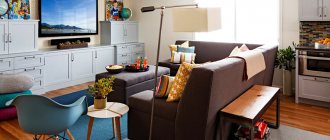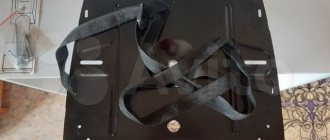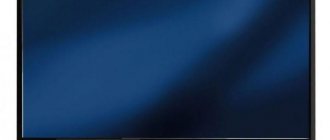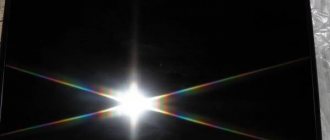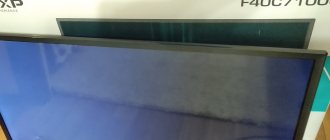With the advent of modern flat and lightweight screens, it has become possible to place televisions not only on legs, stands or pieces of cabinet furniture, but also to hang them from a wall or ceiling. It’s quite possible to do this yourself, saving on installation services. But before that, it is advisable to study all installation methods in order to choose the most suitable one, decide on the location, and take into account important nuances.
Wall mounting is the most popular way to install modern TV devices
Pros and cons of wall installation
All flat-panel TV models come with stands for installation on a flat surface. They are made in the form of supports, secured with screws on the back of the panel body or inserted into special grooves. This is very convenient for those who are replacing old equipment with new ones: you don’t need to think about where to put the purchase, just screw the legs to it and install it in place of the old “box”.
But most owners of flat panels prefer to mount them to the wall, since this installation method provides many advantages, especially relevant for small spaces.
- Saving space - no need to take up space with a TV stand.
- Saving money - a standard hanging mechanism (bracket) costs less than the same cabinet.
- Convenience of using the TV due to placement at a comfortable height and anywhere in the room.
- Safety of operation - the absence of unnecessary furniture that you can trip over or hit, as well as hanging wires that are hidden in grooves, boxes or behind the panel itself.
On a note! Maximum comfort and safety of using the device is ensured by a pre-planned layout of equipment and power outlets.
Having thought in advance about the placement of the TV, you can hide the cables in a special niche.
The wall installation method also has disadvantages. First of all, this is the inability to move equipment to another place without the need to mask holes in the wall left by fasteners. The second drawback is the lack of a horizontal plane for installing a game console, Wi-Fi receiver and other gadgets connected to the TV. For them, you will have to consider the possibility of mounting a shelf next to the TV.
Shelf for devices connected to the monitor
TV placement options
Since now the name “TV” generally means a flat or slightly curved panel with a width/height of more than a meter, one of the options is chosen as the location:
- on a stand. It usually looks like two or more supports that are inserted into special holes in the case or attached to the case with screws. There are no special questions here - the attached instructions will definitely explain how and where to attach them. After this, the plasma with installed supports is placed on any solid horizontal surface. Important - this surface must be really strong (especially for models with a diagonal of 40 inches), not wobbly or movable. A massive cabinet is ideal;
- on the wall. Here, either factory-made brackets of various models are used, or their substitutes are made from “scrap materials”, starting with aluminum corners and ending with boards. We will consider this option in more detail below, since it is the one most often used;
- on the ceiling. Brackets and various kinds of suspension systems are used - even ordinary rope (but this is not for everyone). There are fixed and movable fastenings - with the help of the second type, you can unfold the panel outside of use, while simultaneously lifting it to the ceiling.
Choosing a place on the wall for the television panel
To choose the optimal location of the “plasma”, you need to take into account its size, area and purpose of the room, and the strength of the walls.
Distance to monitor
This is one of the most important parameters for proper installation, affecting the comfort of watching TV shows and eye strain. The distance of a person from a television picture depends on the diagonal of the screen:
- 2.5 meters – with a diagonal of 32 inches (80 cm);
- 3 meters - with a diagonal of 40 inches (100 cm);
- 4 meters – with a diagonal of 55 inches (138 cm) or more.
Therefore, you should not buy a TV that is too large for a small room, since it will not be possible to provide the necessary distance, and watching it will be uncomfortable.
Here the distance clearly does not correspond to the width of the screen
Height above floor
To prevent your eyes and neck from getting tired during a long TV session, an imaginary horizontal line dividing the screen into two equal parts should be slightly above eye level. It is clear that people have different heights, but absolute accuracy is not required here. But you need to consider in what position they will watch TV. And this depends on the room in which it is installed.
- Living room . This room usually contains a relaxation area for the whole family with upholstered furniture. It is best to hang the TV on the wall opposite this area at a height corresponding to the seat height of a person in a chair or on a sofa. Usually it is 120 cm with slight deviations in one direction or another.
- Bedroom . In this room they watch TV while lying or half-sitting in bed. To determine the level of installation of the monitor that is most comfortable for your favorite position, you need to accept it by hanging a picture or other improvised screen on the opposite wall. Then move it up or down until you find the most comfortable position.
Advice! If the bedroom is small, it is better to fix the panel higher so that it does not interfere with free movement, but provide for the possibility of changing its inclination relative to the vertical plane. This can be done using a special bracket.
This position of the screen cannot be considered comfortable - it is better to hang it higher and tilt it forward
- Kitchen . This is the most difficult place to install a TV comfortably. As a rule, it is placed opposite the dining area, but ideally it should also be visible from the desktop. It is not always possible to combine this, especially if you take into account the specifics of the kitchen with a large number of cabinets and household appliances. The monitor should not be placed near an oven, steamer or other devices that heat up and produce steam. It should not interfere with free movement or opening cabinets. Therefore, most often it is suspended at a decent height - and here again you cannot do without mechanisms that allow you to change the position of the screen.
In the kitchen you have to sacrifice comfort for safety.
Note! A TV is an electrical device that heats up when in use. Therefore, it cannot be placed in a small niche or in a tight space between furniture elements - this will interfere with normal ventilation and natural cooling, and will lead to rapid failure of the equipment.
Video – TV wall decor ideas
At what height should I hang it?
There are many tips on the Internet for calculating and maintaining the height of mounting the TV receiver on the wall in different rooms. Most advice does not take into account the recommendations of equipment manufacturers and medical specialists.
Bad advice
- You need to lie down on the bed or sofa and close your eyes. Then the eyes open. and the first point to which the gaze was directed was the center of the television receiver. It is not a fact that in the future it will be comfortable to look at a previously determined point.
- Instead of television equipment, a picture or poster is hung in the intended place. Then they try to look at the hanging element. If you like it, the location is selected for future installation. There is some truth in the recommendation. But it takes a long time to check the correct height. A short-term check will not guarantee that future viewing will be comfortable.
The tips listed above do not take into account an important point. In the living room and bedroom, TV looks quite long. Therefore, it is necessary that when viewing for a long time, neither the eyes nor the body get tired from viewing. A very high setting will cause regular neck swelling.
To make the height as comfortable as possible for long-term viewing, there are clear rules and formulas.
Calculation formulas
Let's look at examples for each room. Slight deviations from the instructions below are not critical. The main thing is that the hanging height is not too high or low.
The main goal is to hang the TV at a level that will minimize stress on the body and visual organ.
Living room (hall)
In the living room, the TV must be placed at one third level.
Let's give an example. In your case, the numbers may differ.
- We sit on the sofa, leaning comfortably on the back of the furniture.
- Using a tape measure, measure the height from the floor to the eyes. It turned out to be 110 cm.
- Eye level should be in the lower third of the screen.
- We measure the height of the TV. We get a value of 71 cm. This means that a third will be approximately 24 cm.
- We subtract the height of the eyes (24 cm) from 110 cm, we get 86 cm. This is the bottom edge of the panel.
- The top edge should be located at a height of 86 + 71 = 157 cm. We received exact boundaries for installing equipment on the wall - 86 and 157 cm from the floor.
- The center of the TV should be at 86+36=122 cm (36 is half the height of the equipment). At this height you need to install the bracket.
Bedroom
For the bedroom, the algorithm for calculating normal height is slightly different.
If the bed is already standing and repairs have been made:
- Sit on the bed so that your back is parallel to the wall.
- Measure the distance from the floor to eye level. This will be the center of the television screen.
Additionally, it is recommended to seek outside help. Have another person lean the TV at the calculated height, and have the TV viewer assume a fully reclining position. If the diagonal is large, then the legs may block the viewing area. Then you need to raise the TV higher.
If the room is under renovation, it will not be possible to experimentally calculate the dimensions. When calculating, standard values are taken:
- The approximate height of the bed is 45 cm.
- Half of the person's height is added to the value. For example, height is 180 cm, then the installation center will be 45+90=135 cm.
This calculation is not as accurate as possible. But already during the repair it will be possible to install the sockets correctly so that they are behind the equipment. In the future, you can adjust the position of the TV, raise it higher if necessary.
It would be useful to take into account the size of the room. If the setting is low and the distance from the bed to the TV is too small, then you can accidentally hit the equipment while passing.
Kitchen
There is no clear formula. There is no need to spend a long time browsing channels, Youtube or Internet TV. The TV in the kitchen is needed for short-term viewing. Therefore, there is no need to get tired. But you still need to take into account some rules:
- The installation is done in a neutral place so that at any time you can turn halfway and see the screen. As a rule, this is the entrance wall to the kitchen (on the right or left, depending on the layout).
- The height is kept higher so that equipment does not interfere when working in the kitchen.
- Do not hang over heating appliances - gas stoves, electric stoves, steamers, etc.
- The television receiver should not interfere with opening cabinets and moving around the kitchen.
How to choose the right bracket
The range of brackets for mounting flat-panel monitors to the wall is very diverse. Among them there are both universal ones, suitable for models from different manufacturers, and special ones, developed for a specific brand.
When purchasing, you should also pay attention to the method of fixing the TV, the recommended maximum load and the equipment of the selected bracket.
Fixation method
Different types of brackets differ from each other in the ability to adjust and change the position of the television device relative to the wall.
- Fixed fasteners are the simplest, most reliable and inexpensive. It has no moving elements, so it holds the panel in a plane parallel to the wall and does not allow it to be moved in any way. This can be inconvenient if viewers decide to change their “dislocation” while watching or if bright light from a window falls on the screen at a certain time of day.
Fixing bracket - Inclined fasteners allow you to change the angle of the monitor within certain limits, usually not exceeding 20 degrees in either direction from the vertical. Used when the TV is placed high or in the bedroom: if you want to watch it lying down or sitting, you just need to slightly adjust the tilt.
Tilt Mount - Rotary and tilt-rotate fasteners are significantly more expensive than previous models, but are more functional. With its help, the monitor can easily rotate as desired and in any plane, turning left and right and tilting up and down.
The mounting panel of the bracket rotates in all directions - The retractable bracket is the most expensive and bulky, but also the most functional, since in addition to changing the angle of the screen and its rotation, it allows you to change the distance from the wall. This can be very convenient when the TV needs to be installed in the kitchen, in a large room or between adjacent rooms.
This design will ensure comfortable viewing from any part of the room.
On a note! For those who value the mobility of the device, floor and table stands with holders for a TV monitor and hidden cable routing have been developed.
Stand with bracket
Video - How to choose a TV bracket
Prices for TV brackets
TV bracket
Equipment
When choosing fasteners, you should make sure that the main and additional elements included in the composition correspond to the configuration declared by the manufacturer. The cheapest brackets are the standard configuration, which in addition to the product itself includes only hardware for installation in the wall. But they may not be suitable for the walls in your home, and this must be clarified immediately in order to purchase the right ones.
More expensive models can be equipped with:
- necessary tool (screwdriver, hex wrench, etc.);
- decorative boxes for hidden laying of wires and cables;
- various holders and shelves for additional accessories;
- remote control for contactless adjustment of the screen position - tilt angle, rotation.
Motorized TV Mount
Maximum permissible load
When purchasing a mount, you must be provided with a product passport and a warranty card. The passport must indicate the permissible load on the bracket, which cannot be exceeded. And if the product has movable joints, then it is recommended to reduce it by at least 10% if the bracket is made by a reputable manufacturer, and by 15-20% if it comes from China.
Another point that requires close attention is the quality of workmanship, the absence of bent parts, chips, unpainted areas and other defects. The presence of which indicates a lack of control over the quality of products.
Equipment surrounded by furniture
There are two ways to properly hang a TV on the wall if it is surrounded by furniture - cabinets, racks, pencil cases, etc.: stationary or on a retractable/swivel bracket.
Important: the load on brackets with movable joints is limited! Large equipment (more than 32 inches diagonal) can be mounted on them only after determining the permissible load! To avoid damage to expensive electronics, it is advisable to reduce the permissible weight by at least 10% when taking into account the specifications of the bracket. Example: the permissible load, according to the manufacturer, is 17 kg, we accept no more than 15 kg. If the bracket comes from China, you can reduce it by 20%. Tested by bitter personal experience.
Fixed means that the position of the panel is fixed, it cannot be tilted/rotated/extended, etc. This is usually done if the audience is located in the same place. If not, then you need to select a bracket that will allow you to rotate or extend the model so that it is clearly visible from other points in the room and the image is not obscured by elements of the furniture set.
Given the light weight of the TV, it can even be attached directly to furniture - for example, to a common wall that combines cabinets and cabinets.
Important: pressed cardboard, MDF or thin chipboard/fibreboard is not suitable for mounting, except for very small equipment. We are talking about wood (furniture panel, solid wood) or boards based on wood-fiber or wood-shaving materials with a thickness of at least 8 mm.
Bracket Mounting
Most fasteners are detachable and consist of two elements. One of them is mounted on the back of the TV, and the second is fixed on the wall. After which they are joined using grooves or other types of connections, which differ depending on the type of structure and manufacturer. Therefore, before starting installation, you should carefully read the instructions.
Designation of mounting holes for the inclined model of the universal bracket
As you can see, universal brackets have not one, but a series of holes or an elongated mounting groove, thanks to which they can be adjusted to different models of television devices, sliding and sliding along the guides.
Installation involves performing several sequential operations.
- Fastening the outer part of the product to the rear panel of the device with the bolts included in the kit.
Mounting points on the rear panel - Monitor position markings. A horizontal line is marked on the wall corresponding to the top edge of the monitor. The correctness of its application must be controlled by the level.
Diagram for determining the height of the monitor - Marking the position of the bracket on the wall. The mating part of the product is applied to the part already installed on the TV and the distance from it to the top edge of the monitor is measured. Lay this distance down on the wall from the horizontal markings, drawing a second horizontal line.
Before setting the marks, the position of the plate is checked again with a level - Marking of attachment points. The mounting plate is applied along the bottom markings to the wall and marks are made on it with a pencil through the mounting holes.
Marks are placed with a pen or pencil - Drilling holes. Mounting holes are drilled at the designated points. The choice of drilling tool and fasteners depends on the wall material - a separate chapter will be devoted to this.
Preparing mounting holes in the wall
Advice! When drilling holes, you can keep the nozzle of the vacuum cleaner turned on nearby so that construction debris does not spill onto the floor.
- Attaching the wall part of the bracket. Dowels are inserted into the drilled holes if the wall material requires it, then the bracket is installed in place and secured with screws or other fasteners.
Installing the bracket on the wall - TV panel installation. After checking the strength of the fastening of the wall part of the bracket, the mating part with the TV is hung on it, after which the device is connected to the network.
Attaching the monitor to the bracket
Video – How to install a TV wall bracket
Prices for levels
level
Bracket Attachment Tool
After selecting the bracket, you need to make sure that you have all the necessary tools for its installation.
List of tools to install the TV bracket on the desired wall:
- Screwdriver. It is better to choose a screwdriver with a ratchet.
- Drill or hammer drill to create the necessary holes in the wall.
- Hammer. Required for installing dowels into holes.
- Fasteners. This includes dowels, screws, bolts and washers.
- Building level. Ensures even placement of the structure.
- Pencil and tape. They will help mark the locations of the holes on the wall.
When preparing the drill, it is important to take into account that its diameter must correspond to the size of the dowel used. The most commonly used standard models are 10×61, designed for a load of up to 15 kg. To secure the bracket with a heavier TV, more robust components may be required.
Other ways to hang a TV on the wall
For some flat screen TVs with a small screen diagonal, it is possible to hang them without additional devices. For this purpose, there are grooves on the back of the panel, specially designed for attaching the plasma by hanging it on bolts screwed into the wall.
To do this, just measure the distance between the grooves, mark them on the wall, drive fasteners into it and fix the TV on it, like a regular poster or mirror. The only difficulty is selecting fasteners designed for the appropriate load.
But this method is not the most convenient, because the monitor fits tightly to the wall, which does not allow you to change its position, place a socket behind it and hide the wires. In addition, the process of ventilation of electronic mechanisms is complicated. Therefore, if the necessary holes are not on the device, or the instructions do not indicate such a mounting option, it is strictly forbidden to use it.
In the absence of factory grooves for direct hanging, it is not recommended to use such fastening methods
But you can make a homemade bracket or hang the TV with the required distance from the wall, using available materials.
Installation on steel angles
From steel corners 3-4 mm thick, 4 pieces are cut, the length of which is 6-8 cm greater than the distance between the mounting holes on the back panel of the TV.
Holes are drilled in one pair of corners for fastening to the back panel of the TV, and in the other for fixing on the wall. After installing each pair in place, they are connected to each other with studs or bolts through holes drilled through.
One pair of corners is attached to the TV through standard mounting holes
The second pair is wall mounted
The corners are fastened together in pairs
Prices for steel angles
steel corners
Installation on furniture corners
Furniture corners are sufficiently rigid and already have holes in the shelves that can be drilled to the required diameter, if necessary.
If you need the TV to hang parallel to the wall, without tilting, then 4 corners are screwed to the back panel - one in each mounting hole. Moreover, the top pair should be fastened with the horizontal shelf facing upwards.
If there are no lower corners or their smaller size, the monitor will hang at an angle
Two corners are attached to the wall at the same distance from each other with the shelf down. Bolts are inserted into them with the rod facing up and must be securely secured with nuts. The corners screwed to the TV are placed on these rods.
The large corner in the center also provides the desired slope
Prices for furniture corners
steel furniture corners
Rotating mechanism made of steel plates and profile pipes
To make such a movable mount yourself, you need to take two steel plates, two pieces of square pipe, bolts for connecting the parts and wall fasteners.
Short sections of pipe are welded to each plate. Through holes are drilled in them, as in two long sections. All these sections are connected to each other by long bolts or studs with nuts.
One plate is fixed on the TV, the other on the wall
There are many other ways. One of the most basic ones is to fix a piece of thick board or block on the wall, and furniture hangers with “ears” on the TV. Screw regular wood screws into the block and hang the monitor on them.
Prices for profile pipes
profile pipes
Video - Bracket made of profile pipes
What distance should there be from the TV?
A large TV screen is not always an advantage. If the room is large and the sofa is far from the opposite wall, then a large diagonal will be better than a small one. You won't need to look closely at the image.
But if the distance from the screen is small, then a very large TV size will cause discomfort.
It can be compared to a movie theater when you sit in the front rows of the theater. You need to constantly turn your head, switch to the changes happening on the screen.
Therefore, before purchasing a plasma, consider the distance to the spectator seat.
Operate with average recommended values:
- 32 inches - 2.5 m;
- 40 inches - 3 m;
- 55 inches or more – 4 m.
Mounting to walls made of different materials
Even the most reliable bracket will not hold the TV on the wall if the wall itself is not strong enough. Before starting installation, you need to find out what it is made of and how firmly it can hold the fasteners.
To concrete and solid brick
Walls made of monolithic concrete and solid brick are the most reliable foundation. The holes in them are drilled with a hammer drill, and dowel-nails or anchor bolts are used as fasteners.
Fastening to a concrete wall
To the tree
This is the most trouble-free material for hanging any equipment, provided the wood is sufficiently thick and of good quality. The brackets are attached to wooden walls with ordinary self-tapping screws, the size of which will ensure that the calculated weight of the device is retained.
For foam blocks and hollow bricks
Wall materials with voids and cavities are not able to withstand heavy loads - they crumble from the applied vertical forces. To ensure reliable installation of the bracket with the TV mounted on it, you need to use special screw dowels with an elongated spacer and wide threads or chemical anchors.
Before installing a chemical anchor, the cavity is filled with quick-hardening compounds
Video - Installation of chemical anchor
To drywall
The method of attaching to drywall depends on the weight of the TV and whether there is a solid foundation underneath the drywall trim. This is a rather fragile material, so installation of any suspended structures on it requires preliminary preparation and the use of special fasteners.
The first method can only be used for installing small monitors on the wall, the weight of which, together with the bracket, does not exceed 10-15 kg. To do this, you will need butterfly dowels, which, when a self-tapping screw is screwed into them, open from the back side of the skin, increasing the area of contact of the fastener to the plane and distributing the load on it.
Butterfly dowel - special fastener for drywall
If the monitor is large and heavy, choose a different mounting method - using long hardware that can pass through the drywall and go deep into the load-bearing wall or partition made of durable materials located behind it. In this case, the type of fastener is selected in accordance with the material of these walls.
Fastening with a long pin through plasterboard sheathing
The described method cannot be applied to plasterboard partitions and false walls, since there is no solid foundation behind them. Therefore, when constructing them, the installation of the TV is planned in advance by installing wooden mortgages at the required level or securing additional metal profiles to the frame.
Installation diagram of a plywood embedding platform
If such mortgages were not provided during the renovation, the TV will have to be installed on a cabinet or purchased a floor bracket-stand.
Prices for butterfly dowels
Butterfly dowel
Video - How to make embeds in a plasterboard wall
Where to buy a bracket?
Buying a bracket today is not difficult; you can find a large selection in any network of digital equipment and electronics stores, for example, M-Video, Eldorado, Tekhnosila, DNS, as well as in online stores such as Yulmart, Enter and others. It is worth mentioning that the DNS company also produces brackets under its own brand. However, the bracket models of this company do not have any significant differences, both in price and in design.
Return to content
Where to put the wires
A power cord running from the TV to the outlet and a dangling antenna cable not only spoil the interior - they create a dangerous situation. By accidentally pulling the wire or tripping over it, you can damage the connectors or even drop the equipment on the floor. And if there are small children and animals in the house, they are at risk of injury from electric shock.
To prevent this from happening, the wires must be hidden. Ideally, you should think about this during construction or renovation, immediately deciding on the location of the TV and placing the socket behind it. For the antenna cable, you can cut a channel in the wall or hide it behind plasterboard cladding.
If you bought a new TV when all the repair and finishing work has long been completed, use decorative methods to disguise the wires - lay them in cable channels, under moldings, in chrome tubes. The choice of “case” depends on the style of the interior.
The black cable channel fits perfectly into the minimalist interior style
Another way is to fix the wire on the wall in several places and disguise it as a tree or vine, attaching elements of artificial plants or decorative stickers to it and to the wall itself.
Disguising wires as a plant
Another practical idea is to hang the TV on the opening facade of a homemade structure in the form of a niche with shelves.
An original way to hide wires and TV accessories
Prices for cable channels
Cable channels
Video - Methods for masking wires
What else to consider
There are no strict uniform rules for installing a TV on a wall. At the same time, you can identify the main landmarks for each zone in the house.
Correct installation criteria
Kitchen
- The optimal height for small kitchens is 175 cm;
- the greater the distance from the working plane to the screen, the higher the plasma can be hung;
- tilt no more than 45 degrees from the center;
- good ventilation on the sides, due to the increased heating of the kitchen as a whole;
- distance from the stove and sink;
- swivel bracket.
Bedroom
- Comfort for the body and neck when viewing from the bed;
- height, for calm coverage with the eyes from a lying position;
- tilt the TV downwards no more than 30 degrees;
- A swivel bracket is desirable.
Living room
- The bracket can be either rotary or stationary;
- screen mounting height from 70 to 140 cm, depending on the viewing distance;
- The further away the viewers, the lower the TV.
It is worth noting that the rule of viewer distance from the screen in the kitchen and living room works differently. This is explained by the posture of the beholders. In a sitting position it is more convenient to see further and lower, in a standing position it is more convenient to see further and higher.
It is also advisable to decide in advance where to locate the wires from the TV. Loose cables can be hidden by pieces of furniture, cable ducts, special covers, or covered with decorative stickers.
You can hang a TV on the wall in different ways using completely different mounts. The choice always depends on your needs, budget, your own preferences and desires.
DIY TV brackets
You can make a good TV holder yourself. If you have the appropriate tools and special skills, you can create a high-quality, safe bracket. Now let's look at some of the most popular options.
Fixed holder made from mounting rail
Installing a TV on the wall with your own hands using such a bracket begins with preparing the tools and material:
- a rail used for fixing wall cabinets of kitchen units;
- dowels;
- fastening elements - screws, screws, bolts;
- perforator;
- Screwdriver Set;
- level and tape measure;
- a hacksaw designed for cutting metal products.
Step-by-step instructions for making a bracket from the most ordinary slats:
- Measure the rail, focusing on the distance between the holes on the back cover of the TV.
- Cut off the required portion of the material.
- If the original holes do not line up with the TV holes, make new ones.
- Based on the length of the already made rail, prepare a similar one for attaching to the wall.
- Attach the first rail to the back of the TV using bolts.
- Mark the wall to prepare the holes where the dowels will be inserted.
- Drill holes using a drill.
- Attach the strip to the wall.
- We insert the strip attached to the back cover of the TV into the grooves of the strip hanging on the wall.
- This completes the work.
Cheap wooden bracket
This option is suitable for owners of small TVs. The mount is not able to support a heavy device with a bulky screen. List of required equipment and materials:
- wooden board with a cross section of up to 10 cm;
- 4 hanging hooks;
- 4 ring-shaped self-tapping screws;
- 4 mounting bolts;
- saw;
- perforator;
- a simple pencil and a tape measure.
Step-by-step instructions for making a wooden bracket with your own hands:
- According to the length of the TV screen, you need to cut the wooden strip into two parts.
- Ring-shaped screws are attached to the end of the product.
- The fasteners should not be too close to the edge of the equipment, otherwise the bar will crack.
- Use a hammer drill to make holes in the wooden planks and install the TV on them.
- Mark on the wall according to how the rings will be placed on the slats.
- Once the holes are made, attach the hanging hooks.
- We hang the TV by inserting the rings into the hooks.
Adjustable metal mount
It is almost impossible to make a full-fledged universal bracket that allows you to change the location of the screen yourself. However, you can try to imitate this product. To implement your plan, you will need the following tools and materials:
- metal tube in the shape of a square.
- 4 corners of 25 mm;
- square metal plates;
- fasteners: bolts, nuts, washers, dowels;
- saw for cutting metal products;
- perforator;
- brush and paint;
- drills for working on metal surfaces.
Product preparation algorithm:
- You need to drill 4 holes around the perimeter of the slab into which dowels will be inserted.
- On the second plate it is necessary to drill holes in accordance with the design of the back cover of the TV.
- The tube must be cut into 3 parts. The first will serve as a wall fixation bracket. The second will act as a connecting element. The third will allow you to attach the TV. The user determines the length of the metal sections independently.
- All prepared metal pieces must be painted, otherwise they may rust.
- When the paint is dry, use bolts to secure two corner pieces in the center of each slab. As for the distance between these corners, they must be selected in such a way that the structure can easily change its position.
- Metal pieces are fixed between the corners and bolts. However, you first need to prepare special holes.
- We fasten the sections between the corners, placing special washers between these structural elements.
- The central part is connected by the largest bolts.
- Fix the slabs with attached tubes to the wall with dowels. To improve the strength of the structure, also use bolts. Then you can connect the holder and TV.
- Adjust the angle and then tighten the nuts.
It is imperative to note the fact that the most reliable homemade brackets still cannot guarantee maximum security. Features if you have never created such products before. Therefore, if you doubt your skills, it is better to buy the bracket from the appropriate store.
Types of fasteners
Various types of brackets are used for installation. They differ in size and functionality. The choice of bracket is very important as it will be used for many years. The following must be taken into account:
When purchasing, you need to check the package contents. It should not be the case that any parts are missing during installation. You need to choose the bracket option that will be most convenient for the specific type of screen and the room chosen for installation
For example, when using a widescreen screen, it is important to choose a mount that will allow you to install it at the desired angle. It should be taken into account that the kit may include additional elements. For example, a special box may be provided designed to mask the location of the wires. You need to pay attention to the quality of workmanship and assembly. It is not recommended to purchase products that have scratches, chips or other damage. Some brands of brackets provide control using a remote control. When using them, you can adjust the location of the screen while watching without getting up from your seat.
Ceiling fastener
Ceiling mounting is convenient for use in the kitchen or large rooms. This type of mounting allows you to install the equipment at any desired angle. Horizontal rotation is allowed up to 360 degrees, and vertical rotation is within 90 degrees. Ceiling fasteners are often used in spacious studio kitchens or in places visited by a large number of people.
Rigid fastener
Using a rigid bracket results in a rigid fixation of the screen position. It can only be secured in a vertical position. Its main advantage is the relative ease of installation compared to other options.
The lack of moving elements makes it impossible to adjust the screen position. When using such a mount, you must carefully select the installation location. Such brackets have a lower price.
Tilt-and-swivel pull-out design
Inclined fastener
When using an inclined mounting option, the screen is placed at a certain angle to the wall in a vertical plane. During installation, it is not possible to adjust the screen position to the right or left.
Swivel fastener
Use a rotating bracket to change the angle of the screen relative to the wall in the horizontal plane. There is no provision for turning up or down. Such screens are usually installed at eye level of the audience. There are tilt-and-turn designs. They allow you to adjust the position in any desired direction.
If a retractable structure is used, it additionally allows you to increase or decrease the distance to the wall. This design has a significant volume, so it is not recommended for use in small rooms.
Installation without bracket
You can hang the screen on the wall without using a bracket. This is permissible in cases where the design provides special ears. They look like grooves. The installation procedure is no different from attaching a picture to the wall. However, in this case, adjustment of the screen rotation angle will not be available.
It is important to choose a fastener that can easily support the weight of the equipment. It should be borne in mind that the use of ears is less reliable compared to the use of a bracket
